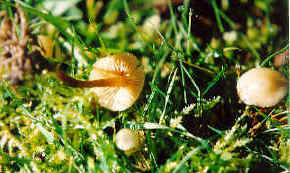|
[ Ascomycetes ] [ Basidiomycetes ] [ Books ] [ Classification ] [ General info. ] [ Slime Moulds ] [ The New Zealand Bush ]
|
| This is a very large family. Some of it's members live on wood
others are terrestrial, (from ground). Their spore prints are generally brown, but various shades of brown are
common!! |
|
|
Group: Cortinarius
Members of this group are known for the presence of a cobwebby veil known as 'The Cortina', this veil
often leaves hairs on the stalk which become most visible when dusted with spores. Most live on the ground. |
Amanitaceae
Boletaceae
Bolbitaceae
Clavariaceae
Coprinaceae
Cortinariaceae
Dacryomycetales
Ganodermataceae
Hydnaceae (Teeth Fungi)
Hygrophoraceae
Lycoperdales
Nidulariales
Phallales(Stink Horns)
Pluteaceae
Podaxales
Polyporaceae
Russulaceae
Schizophylaceae
Strophariaceae
Tremellales & Others
Tricholomataceae
Tulostomatales
Steriaceae |
|
Cortinarius alboviolaceus
Found at Lake Waikeramoana on May 10, 2001 at the a5th Annual New Zealand Fungal Foray.
Quite a sight. The slimiest cap surface ever and the most beautiful purple colour to the gills and
stem!!! Large Mushroom and quite abundant.
Cap: 5-10cm in diameter. Umbonate, the umbo is brown while the margin is tan to beige in colour. Cap
Surface very gelatinous!!
Gills: Bright purple in colour. Free from stalk.
Spore print: Brown.
Stalk: 5-9cm tall and about 1.5-2cm thick. Smooth and purple in colour with a white base.
Habitat: On ground.
Edibility: I don't know!!
This photo is shaken, would have made a great shot!!
|
|

 |
Amanitaceae
Boletaceae
Bolbitaceae
Clavariaceae
Coprinaceae
Cortinariaceae
Dacryomycetales
Ganodermataceae
Hydnaceae (Teeth Fungi)
Hygrophoraceae
Lycoperdales
Nidulariales
Phallales(Stink Horns)
Pluteaceae
Podaxales
Polyporaceae
Russulaceae
Schizophylaceae
Strophariaceae
Tremellales & Others
Tricholomataceae
Tulostomatales
Steriaceae |
|
Cortinarius ochroleacus
Found in July, 2000.
Cap: White-tan in colour. Dry, smooth surface. About 1.5-2cm in diameter, (can be up to 8cm).
Gills: Same colour as the cap, turning brown at maturity. Closely packed and deep, attached to stalk and
running down it slightly.
Spore print: Rusty brown. (see link below)
Stem: White-tan. Thicker at the connection with the gills. About 4mm thick and 5-6cm tall.
Edibility: Unknown? (i.e. DON'T EAT IT!!)
|
|

 |
|
|
Group: Gallerina & Tubaria
Members of this group are usually small to minute in size. Caps are sometimes slimy when moist and
striate to the margin. They can be found growing on wood or ground. The stem is usually hollow, thin and fragile.
A partial veil is present on some. Spore prints are various shades of brown. |
Amanitaceae
Boletaceae
Bolbitaceae
Clavariaceae
Coprinaceae
Cortinariaceae
Dacryomycetales
Ganodermataceae
Hydnaceae (Teeth Fungi)
Hygrophoraceae
Lycoperdales
Nidulariales
Phallales(Stink Horns)
Pluteaceae
Podaxales
Polyporaceae
Russulaceae
Schizophylaceae
Strophariaceae
Tremellales & Others
Tricholomataceae
Tulostomatales
Steriaceae |
|
Gallerina mycenopsis
Found in July,
2000.
Cap: Light brown to orange brown with a waxy appearance when moist. Distinctly striate. Has a notch on
the center which is darker in colour than the rest of the cap. 1-1.2cm in diameter.
Gills: Similar in colour to the cap but slightly paler and attached to the stalk.
Spore print: Light-Orange brown. (click on link below to see spore print)
Stem: Darker in colour than the cap especially towards the base. About 3mm thick and 3-4 cm high.
Edibility: Unknown? (i.e. DON'T EAT IT!!!)
|
|



|
|
|
Group: Inocybe
This group has a brown spore print. Usually terrestrial. Stalk central without a partial veil or if
present then, like the family cortinariaceae, cobwebby!! |
Amanitaceae
Boletaceae
Bolbitaceae
Clavariaceae
Coprinaceae
Cortinariaceae
Dacryomycetales
Ganodermataceae
Hydnaceae (Teeth Fungi)
Hygrophoraceae
Lycoperdales
Nidulariales
Phallales(Stink Horns)
Pluteaceae
Podaxales
Polyporaceae
Russulaceae
Schizophylaceae
Strophariaceae
Tremellales & Others
Tricholomataceae
Tulostomatales
Steriaceae |
|
Inocybe calamistrata (Scaly Inocybe)
Found at Tangoia Falls on December 15, 2000 growing from ground amongst Shaggy manes.
Cap: 1-4cm in diameter. Bell shaped and covered in brown scales or hairs on a paler background.
Gills: Rusty brown but supposed to be white when young.
Spore print: Brown.
Stem: Same colour as cap but less scaly than the cap!!5-6 cm tall and about 0.4-0.5 cm thick.
Partial veil absent or appears to be.
Volva or cup absent.
This mushroom is uncommon, in some books it is considered rare.
Edibility: unknown, however there is a study claiming it contains traces of psilocybin!! (Don't eat it!!) |
|

 |